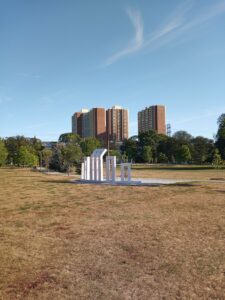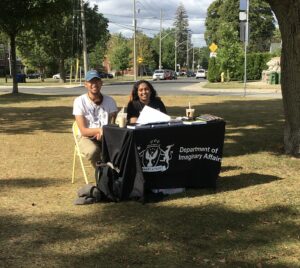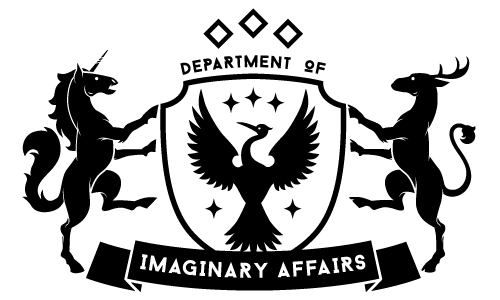
Hello Radiant Human, before you start reading & imagining pt.2 of this blogpost, we encourage you to read pt.1 here to get yourself imagining your day with both Ari and I [Elvin].
Without further ado, let’s dream away back into tabling for the first time as a team. Ari and I [Elvin] were also curious about the communities that felt comfortable engaging with us at the table that morning, and those who didn’t. Here are our reflections on our attempts to engage the communities this project was created for.
Elvin: It was also interesting how the POC’s there were just like staring at us and the white folx in the area were so willing to interact with us and share their stories. When we shared the scope of the project – what it was about, who it would focus on, how we were trying to prioritize BIPOC stories – you could see these white folx just start to close up and their behaviour changed. When the immigrants who lived in the area came to the table, they weren’t really engaged in what we were doing and that’s a bit of a problem right now.
Ari: I think the most challenging part of tabling has been that, we know why A Tale of Two Parks and collecting BIPOC stories and experiences is important, but like conveying that to someone who is cutting through Dentonia Park to get home after a long day at work doesn’t always land, and I think what I’m trying to do now is figure out how to make it interesting and worthwhile for the newcomer/immigrant population that frequents Dentonia Park. I think also when you ask someone to share a memory or story with you, there’s this assumption that it has to be this big, traumatic, notable event, but that’s not always the case. We could literally hear stories about people’s day to day life and that would be just as vital to the project because we’re trying to focus on how people exist in these spaces.

Elvin: Yeah, even when we were sitting there and observing the Tai Chi class that was happening, we thought it was so interesting and really wanted to document their reasons for coming to this park specifically, but we also didn’t want to intrude on their practice, especially because they are POC’s and we didn’t want to invade boundaries. But even when we walked by them they were a bit rattled that we were so close to them. When we were at the park, you could tell that people really didn’t want to interact with us even when we were open at the table and they could come up to us as they felt comfortable. It goes full circle to the fact that white individuals were so easily able to have the privilege to come to us and be open with us because they are part of the dominant culture, but with POC’s and immigrants it was so hard to try and find that middle ground and create that connection with them.
Ari: I think what’s funny is that when I’m at the park tabling and I see older South Asian people there, I know how they expect me to behave or act in terms of what they perceive my gender to be and what my ‘role’ as an AFAB (assigned female at birth) South Asian person is in their eyes, but I think what they expect of me and what I’m trying to do at the park with this project kind of clashes a little bit. Collecting these stories and just tabling in general requires like an independence and an outgoing quality that South Asian “womxn” aren’t expected to practise, so I think sometimes that throws people off a bit. It’s been a bit confusing for me trying to figure out how to interact with that demographic without disrupting them or being disrespectful or just getting caught up in my own thoughts and perceived expectations around my cultural community.
Elvin: That being said, it’s not like we believe that some stories are more valuable than others in this project. We really want to amplify any and all BIPOC stories because those stories rarely get amplified in these spaces. This is true especially when thinking about parks which is also a place of privilege for folx, so we really want to make sure to distinguish that everyone’s stories are valuable, but in this moment, we’re trying to amplify BIPOC stories, not isolate white folx and make them feel like their experiences aren’t valid.

Ari: I think you also mentioned for yourself that parks have always been a place of solace for you, and I think that’s also very true for these Black and Brown families and for people that we see at the park, and I feel sometimes they don’t want to engage, sometimes they’re just at the park existing and I don’t want to interrupt them either. So I think I’m just curious about the different ways that we can try to reach out to these folx and get them involved if they feel comfortable doing so.
Elvin: We were also conscientious about people’s boundaries especially since we’re in a pandemic and doing the work to figure out how to interact with people and really listen to the stories that we’re hearing. It also doesn’t have to be people sharing their trauma with us at the park, they could literally talk about how they love enjoying the community and seeing everyone be there together. It doesn’t always have to be a sad story. I think that’s also a pressure we face as BIPOC people, when we share our stories we are always steered towards sharing what’s difficult and traumatic about our lives but it’s also important to hear about people just relaxing and wanting to rejuvenate themselves at the park, that is also a valid and important experience.
In this conversation, we reflected on the differences and attitudes between who approached and avoided us as we were tabling. We tried to brainstorm more effectives ways of reaching the communities we set out to create this project for.
Lessons that came out of this experience were:
🌱 Tabling is not always an effective mode of outreach to engage folx in a comfortable way as it creates a dynamic where it’s
🌱 Our presence at the park may contradict with the reason folx use the park – relaxing, rejuvenating, winding down from the pressures of the day
From these lessons, this sparked some questions & insights to think about:
✨Do BIPOC community members feel uncomfortable with folx who are tabling because they have never seen them before in the area? Or is it an assumption that they view people tabling as someone that is offering them a service/to sign up for something/collect their name & number – intruding their own privacy – in a space that is meant for solace?
✨What support do BIPOC communities in the Crescent Town/Dentonia Park area need?
✨How can we make BIPOC community members feel comfortable in participating in our project in a meaningful way? What can this engagement look like?
As we move forward with this project, we constantly try to adapt what we do and how we do it to make sure we are meeting the needs of the communities we are engaging with. We want to hear your feedback on how we move forward with ‘A Tale of Two Parks’. We want to offer the communities we are working with to provide us with suggestions and criticism on how we collect stories and share them. To get involved and share your feedback, we encourage you to please email Ari (ari@dia.space) or Elvin (elvin@dia.space). We look forward to listening to your insights and incorporating them through our process. Until then, tune-in on our social media for more updates on how to be a part of this project.
